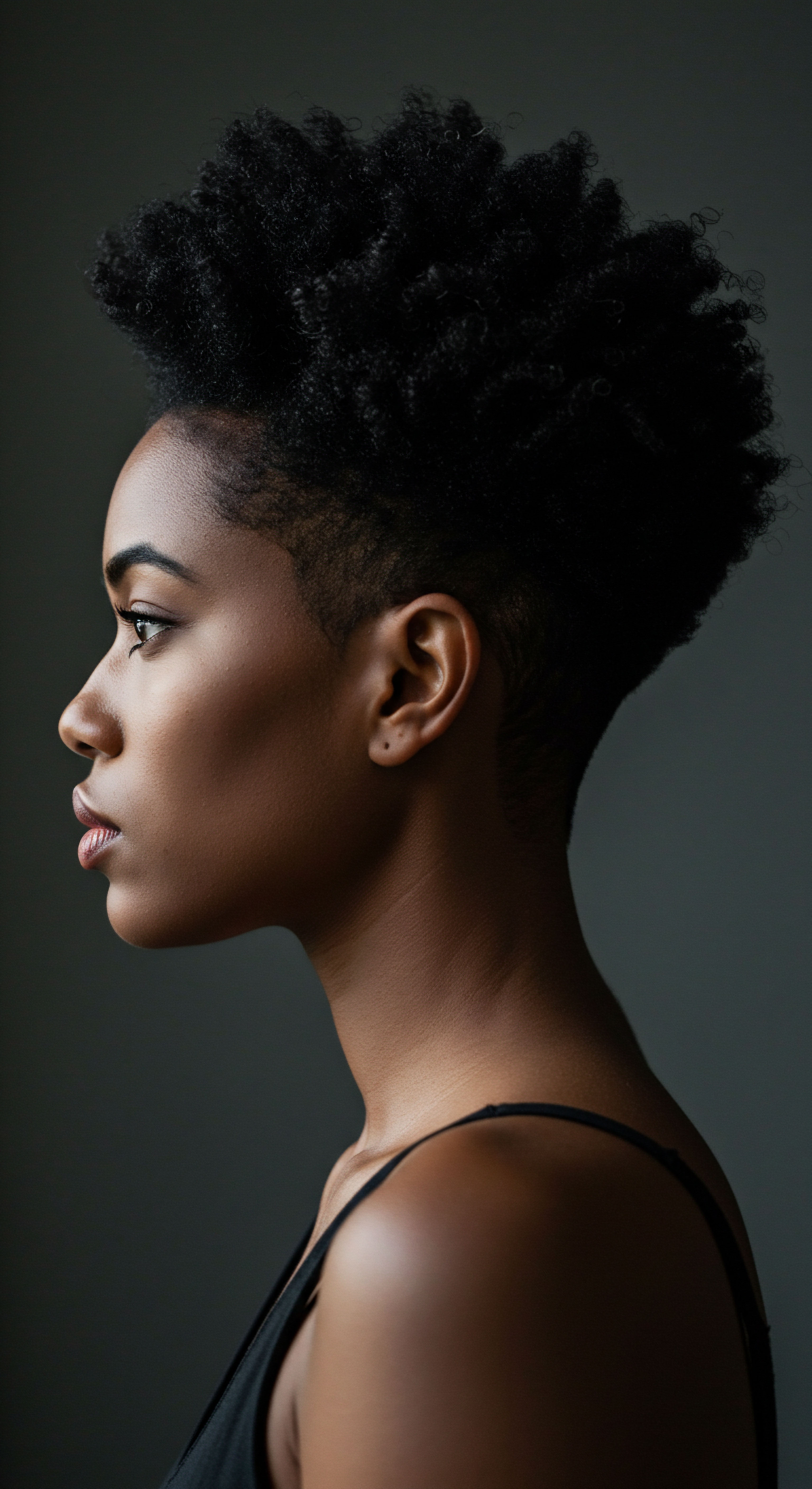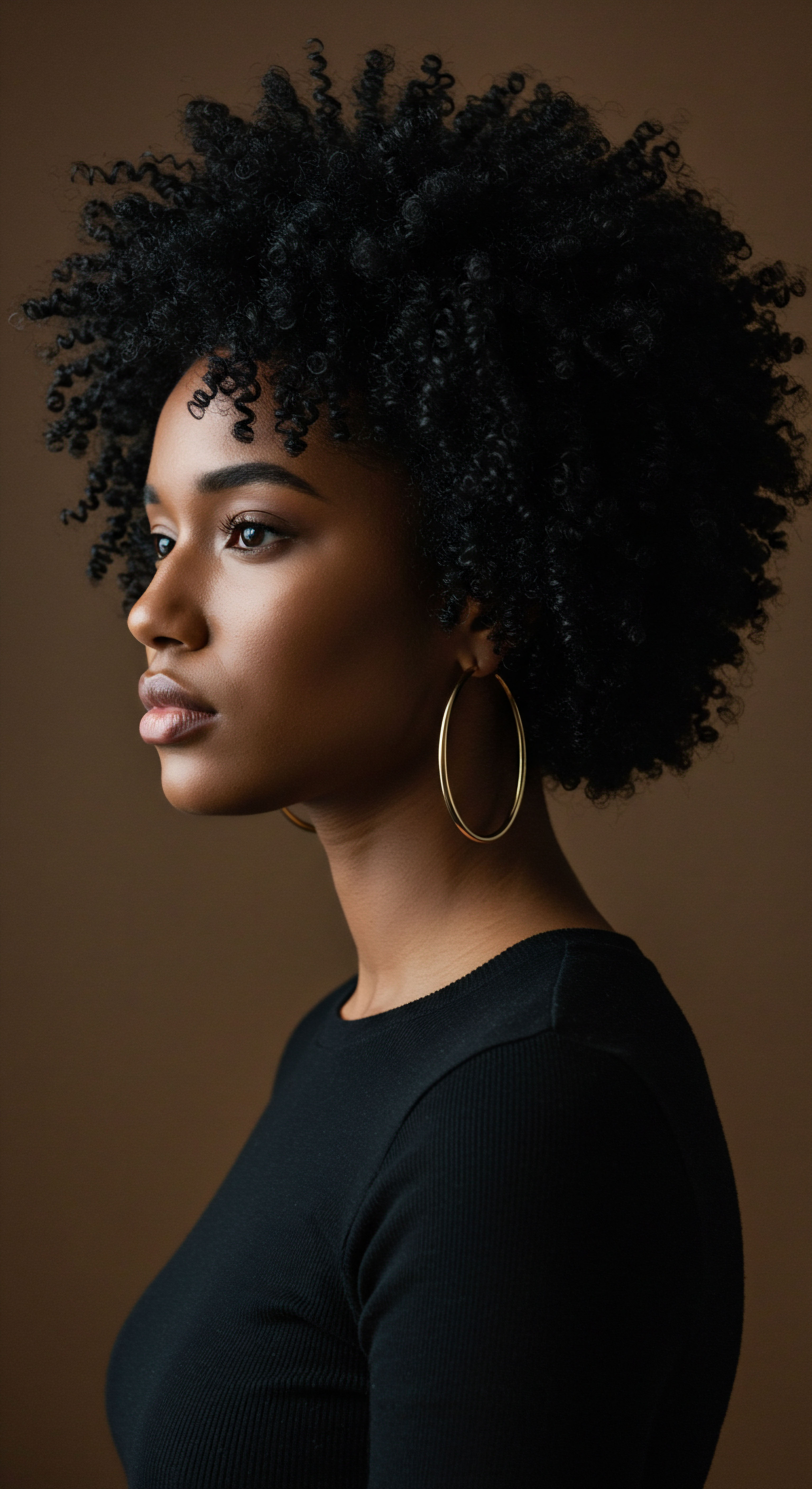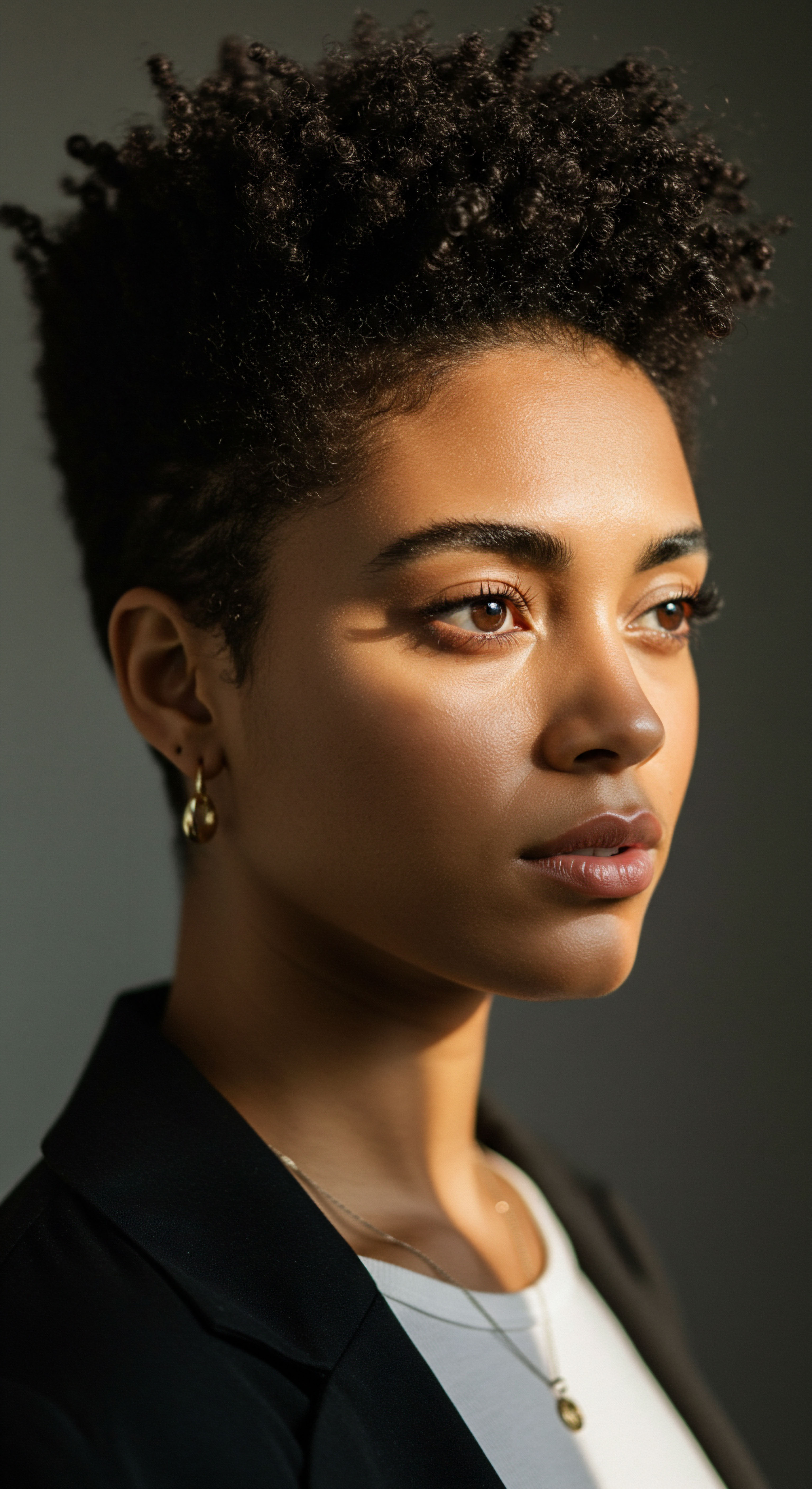
Roots
There exists a quiet language our hair speaks, a silent dialogue of its innate nature. It whispers of its thirst, its receptivity, or its guarded resistance to the moisture and nourishment we offer. This silent communication is the very concept of hair porosity, a fundamental aspect of hair health that shapes how each strand interacts with the world around it. To truly comprehend how chemical treatments redefine this interaction, we must first listen closely to the hair’s inherent voice, understanding its structure from the inside out.
Hair, in its magnificent simplicity, is a complex protein filament, a testament to biological artistry. Each strand emerges from a follicle, a tiny pocket nestled within the scalp. While the visible portion, the hair shaft, appears uniform, it is composed of distinct layers, each serving a particular purpose in the hair’s overall resilience and appearance. These layers work in concert, much like the delicate petals of a bloom, each contributing to the whole.

The Hair’s Protective Outer Layer
The outermost layer, the Cuticle, functions as the hair’s primary shield. Picture it as a series of overlapping scales, akin to shingles on a roof or the scales on a pinecone. In healthy hair, these scales lie flat and compact, creating a smooth, reflective surface. This tight arrangement restricts the entry and exit of substances, contributing to what we term low porosity.
Hair with low porosity tends to resist moisture absorption, often causing water to bead on the surface before it can truly sink in. Yet, once moisture penetrates, it tends to stay, holding hydration well.
Conversely, when these cuticle scales are raised or compromised, they create openings, permitting substances to pass through more freely. This condition is indicative of high porosity. Hair exhibiting high porosity readily absorbs moisture, often feeling softer to the touch when wet.
However, this ease of entry also means an ease of exit; moisture can escape just as swiftly, leaving the hair prone to dryness and often feeling rough or brittle. The state of these cuticle scales directly dictates the hair’s porosity level.

The Core of the Strand
Beneath the cuticle lies the Cortex, the hair’s veritable heart. This layer constitutes the bulk of the hair shaft and is primarily composed of tightly packed bundles of keratin proteins. These proteins are responsible for the hair’s strength, elasticity, and its unique texture. Within the cortex, melanin pigments reside, giving hair its distinctive color.
The integrity of the cortex is paramount; any compromise to its protein structure can profoundly affect the hair’s strength and overall health. The cortex also contains water-binding components, making its condition vital for moisture retention.
At the very center of some hair types, a soft, inner core known as the Medulla may be present. Its precise function remains a subject of ongoing inquiry, but it is generally thought to contribute to the hair’s structural integrity, particularly in coarser strands. Not all hair strands possess a medulla, and its presence can vary even within an individual’s hair. While less directly tied to porosity than the cuticle, the medulla plays a supporting role in the overall architecture of the hair fiber.
Hair porosity, a measure of how readily strands absorb and retain moisture, is primarily determined by the state of the cuticle, the hair’s protective outer layer.
Understanding these foundational elements is not merely an academic exercise; it is a profound recognition of the hair’s delicate biological machinery. When we introduce chemical treatments, we are, in essence, interacting with this machinery, prompting changes that can redefine the hair’s intrinsic nature. The hair’s natural porosity, whether low, medium, or high, serves as our baseline, a starting point from which to observe the transformative effects of these powerful agents.
The hair’s ability to absorb and retain moisture is a dynamic property, not a static one. While genetics certainly play a role in setting our initial porosity, external factors, particularly the application of chemical treatments, can dramatically shift this inherent characteristic. It is this interplay between the hair’s natural state and the alterations imposed by chemical processes that truly shapes its subsequent needs and behaviors.

Ritual
The practices we undertake with our hair, whether daily rituals of cleansing and conditioning or periodic acts of transformation, reflect a deep engagement with our strands. When these practices extend to chemical treatments, we invite a potent dialogue with the hair’s very structure. This section steps into the practical realm, exploring how these powerful agents, from relaxers to colorants, deliberately alter the hair’s architecture, thereby redefining its porosity. This is not simply about surface change; it concerns a fundamental reordering of the hair’s components, with lasting implications for its capacity to hold hydration.

Altering the Hair’s Protein Bonds
Chemical treatments operate by initiating reactions that break down and then reform the hair’s natural bonds. The disulfide bonds within the hair’s cortex are particularly resilient, contributing significantly to its strength and natural curl pattern. Treatments like Chemical Relaxers, designed to permanently straighten textured hair, utilize alkaline agents such as sodium hydroxide or guanidine hydroxide. These potent chemicals swell the hair shaft, allowing them to penetrate the cuticle and reach the cortex.
There, they break a significant portion of the disulfide bonds, causing the hair’s coiled structure to loosen. Once the bonds are broken, the hair is mechanically straightened, and then neutralizing agents are applied to reform the bonds in their new, straighter configuration.
This process, while effective in altering texture, inherently compromises the cuticle. The strong alkaline solutions cause the cuticle scales to lift extensively, often leaving them permanently raised or even damaged. This lifting action directly increases the hair’s porosity, making it more susceptible to moisture loss and external aggressors. The hair becomes more receptive to water, yet struggles to retain it, creating a constant need for deep conditioning and sealing practices.
Similarly, Permanent Waves, or perms, also rely on breaking and reforming disulfide bonds, though their aim is to create curl. An alkaline waving solution, often containing ammonium thioglycolate, is applied to hair wrapped around rods. This solution breaks the bonds, allowing the hair to take on the shape of the rod. A neutralizer, typically hydrogen peroxide, then reforms the bonds, locking in the new curl pattern.
Just like relaxers, the initial alkaline solution causes the cuticle to swell and lift, leading to an increase in porosity. The hair, post-perm, will likely absorb products more readily but also require consistent efforts to maintain its hydration.

Introducing Pigment and Its Consequences
Hair Coloring, particularly permanent dyes and lightening agents, also profoundly impacts porosity. To deposit new color molecules or to lighten the existing pigment, the hair’s cuticle must be opened. Lighteners, which typically contain hydrogen peroxide and ammonia, work by penetrating the cuticle to reach the cortex and break down the melanin pigments. This oxidative process, while achieving the desired shade, is highly disruptive to the cuticle.
The scales are forcibly lifted, and often, portions of the cuticle can be eroded or stripped away entirely. This results in a significant increase in porosity, leaving the hair feeling rough, looking dull, and prone to tangling.
Permanent hair dyes also use ammonia to swell the cuticle and allow color molecules to enter the cortex. While generally less aggressive than lightening, repeated coloring still contributes to cuticle damage and elevated porosity. Even semi-permanent or demi-permanent dyes, though gentler, can slightly lift the cuticle to deposit color, leading to minor increases in porosity over time, particularly with frequent use.
Chemical treatments like relaxers, perms, and permanent dyes intentionally alter hair structure by breaking and reforming bonds, inevitably leading to increased porosity due to cuticle disruption.

Understanding the Chemical Impact on Porosity
The immediate and observable impact of these treatments is a shift in the hair’s porosity level. Hair that was once low porosity might become medium or even high porosity after a chemical service. This altered state dictates a new approach to care, one that prioritizes sealing the cuticle and replenishing lost moisture and protein. The hair’s surface, once a smooth, tightly closed barrier, becomes a more open, reactive landscape.
- Relaxers ❉ These alkaline agents swell the hair and break disulfide bonds, leading to a permanent lifting and potential erosion of the cuticle, significantly raising porosity.
- Perms ❉ Similar to relaxers, perming solutions open the cuticle to restructure bonds, resulting in a more porous hair shaft that absorbs and loses moisture more readily.
- Hair Dyes ❉ Particularly lightening agents, these chemicals force open the cuticle to modify pigment, causing physical damage and leaving the hair with elevated porosity.
The journey with chemically treated hair becomes one of thoughtful replenishment and protection. The hair’s increased porosity means that water, conditioning agents, and even styling products can enter the hair more easily, but also depart with equal swiftness. This necessitates a routine that focuses on layering products, using emollients to seal the cuticle, and protein treatments to help temporarily patch the gaps created by the chemical process. The ritual of care adapts to the hair’s transformed state, recognizing its new thirst and its vulnerability.
| Treatment Type Chemical Relaxers |
| Primary Chemical Action Breaks disulfide bonds, restructures hair |
| Effect on Cuticle Extensive lifting, erosion, permanent damage |
| Typical Porosity Shift Significant increase to high porosity |
| Treatment Type Permanent Waves (Perms) |
| Primary Chemical Action Breaks and reforms disulfide bonds |
| Effect on Cuticle Significant lifting, structural weakening |
| Typical Porosity Shift Increase to medium or high porosity |
| Treatment Type Permanent Hair Color |
| Primary Chemical Action Ammonia swells cuticle, peroxide alters pigment |
| Effect on Cuticle Lifting, potential erosion, physical alteration |
| Typical Porosity Shift Increase to medium or high porosity |
| Treatment Type Lighteners (Bleach) |
| Primary Chemical Action Oxidizes melanin, removes pigment |
| Effect on Cuticle Aggressive lifting, stripping, severe damage |
| Typical Porosity Shift Substantial increase to very high porosity |
| Treatment Type Each chemical process alters the hair's natural barrier, requiring tailored care. |
This redefinition of porosity is not merely a side effect; it is an inherent part of the chemical transformation. Acknowledging this fundamental shift allows us to approach hair care with intention, providing the precise support and nourishment required for strands that have undergone such profound structural change.

Relay
Our hair, in its myriad forms, carries not only our genetic code but also the echoes of cultural practices, personal choices, and the silent testament of scientific alterations. To truly grasp how chemical treatments redefine hair’s porosity, we must move beyond the surface-level observation and delve into the intricate interplay where biology, chemistry, and lived experience converge. This section unearths the deeper truths, the less apparent complexities that chemical processes unearth, examining how science and cultural contexts inform our understanding of hair’s altered state.

Beyond the Surface How Chemicals Penetrate Hair?
The ability of chemical agents to penetrate the hair shaft and elicit a desired change hinges on their capacity to bypass the cuticle. This penetration is often achieved through several mechanisms, each contributing to the alteration of porosity. Alkaline Agents, common in relaxers and permanent dyes, cause the hair shaft to swell. This swelling forces the cuticle scales to lift, creating pathways for the active chemicals to reach the cortex.
The degree of swelling is directly related to the pH of the chemical solution; higher pH values lead to greater swelling and more significant cuticle disruption. For instance, a typical relaxer can have a pH as high as 12-14, which is highly alkaline and corrosive.
Another mechanism involves the use of Solvents. Some hair dyes, for example, may contain solvents that help to dissolve and carry the dye molecules into the hair. While not as aggressive as alkaline swelling, these solvents can still disrupt the lipid layer on the cuticle surface, making the hair more permeable. The physical manipulation during application, such as combing or brushing, also contributes to the mechanical stress on the already compromised cuticle, further exacerbating porosity issues.

The Structural Cost of Chemical Transformation
The changes wrought by chemical treatments are not merely superficial; they are profound structural reconfigurations at a molecular level. When disulfide bonds are broken, and the hair is reshaped, the hair fiber’s natural integrity is challenged. This can lead to a reduction in the hair’s tensile strength, making it more susceptible to breakage. Furthermore, the extensive lifting and damage to the cuticle can expose the delicate cortex to environmental stressors, such as UV radiation and humidity fluctuations, accelerating protein loss and moisture depletion.
Consider the findings from a study published in the Journal of Cosmetic Science (Robbins & Kelly, 2007). Their research on the effects of chemical straightening on hair fibers revealed that repeated chemical processing significantly reduced the mechanical properties of the hair. Specifically, they observed a decrease in the hair’s Tensile Strength and an increase in its Elasticity Modulus, indicating a stiffer, less pliable fiber.
This alteration in mechanical properties directly correlates with increased porosity, as the structural damage creates more pathways for substances to enter and exit. The study highlighted that the damage was cumulative, meaning each subsequent chemical treatment added to the existing structural compromise, leading to progressively higher porosity and greater vulnerability.
Chemical treatments induce profound structural reconfigurations within hair, compromising its integrity and leading to increased porosity, a cumulative effect evident in reduced tensile strength.
This scientific insight underscores that the hair’s response to chemical treatments is a dynamic process, where initial damage sets the stage for further vulnerability. The hair’s natural resilience is gradually diminished, requiring a more deliberate and consistent approach to care that addresses its heightened needs.

Cultural Contexts and Porosity Shifts
The decision to chemically treat hair is often deeply rooted in cultural practices, aesthetic preferences, and historical contexts. For individuals with textured hair, chemical relaxers have long been a prevalent choice, influenced by societal beauty standards that historically favored straighter hair textures. This cultural impetus often leads to repeated chemical applications over many years, creating a cumulative effect on porosity that can be particularly challenging to manage.
The legacy of chemical straightening within Black communities, for instance, presents a unique dimension to the porosity discussion. Generations have navigated the complex relationship between desired aesthetics and the physiological changes induced by relaxers. This consistent chemical alteration means that for many, their hair’s porosity is not simply a natural predisposition but a product of sustained chemical intervention. Understanding this historical and cultural context allows for a more empathetic and effective approach to care, recognizing that the hair’s current state is a product of both nature and nurture, of biology and societal influence.
This cultural practice, while offering a desired aesthetic, comes with the physiological reality of altered hair structure. The continuous breaking and reforming of disulfide bonds, often on hair that is already fragile from previous treatments, pushes the hair into a state of consistently high porosity. This demands a specialized care regimen focused on sealing the cuticle, providing consistent moisture, and minimizing further mechanical stress. The conversation around porosity in textured hair, therefore, extends beyond mere scientific explanation; it touches upon identity, history, and the choices made in the pursuit of beauty.
- Alkaline Swelling ❉ High pH chemicals cause the hair shaft to expand, forcing cuticle scales open for chemical entry.
- Solvent Action ❉ Certain dye components act as solvents, disrupting surface lipids and increasing permeability.
- Mechanical Stress ❉ Physical manipulation during chemical application further compromises cuticle integrity.
The relay of knowledge, from scientific discovery to lived experience, provides a comprehensive picture. Chemical treatments are not merely cosmetic alterations; they are profound chemical transformations that permanently reshape the hair’s ability to interact with moisture. This altered porosity, often a cumulative result of repeated applications, requires a thoughtful, informed, and culturally sensitive approach to hair care, recognizing the profound connections between our hair’s biology and the stories it tells.

Reflection
Our exploration into the intricate dance between chemical treatments and hair porosity concludes not with a definitive end, but with an invitation to deeper understanding. We have witnessed how the very structure of our hair, from its protective cuticle to its resilient cortex, responds to the transformative power of chemical agents. The hair, once a silent observer of its natural state, becomes a dynamic canvas, forever changed by the hand of human innovation and cultural expression.
This journey through the science and stories of hair reminds us that care is not a static concept, but a continuous dialogue, adapting to the hair’s evolving needs. May this insight serve as a gentle guide, empowering each of us to listen more closely to our hair’s unique voice, nurturing its strength and beauty in every phase of its existence.

References
- Robbins, C. R. & Kelly, D. A. (2007). The effect of chemical straightening on the mechanical properties of human hair. Journal of Cosmetic Science, 58(4), 381-392.
- Feughelman, M. (1997). Mechanical Properties of Hair. Springer-Verlag.
- Gavazzoni Dias, M. F. (2015). Hair Cosmetics ❉ An Overview. International Journal of Trichology, 7(1), 2-15.
- Schueller, R. & Romanowski, P. (2017). Conditioning Agents for Hair and Skin. CRC Press.
- Trueb, R. M. (2008). The role of vitamins and minerals in hair loss ❉ A review. Dermatology and Therapy, 1(1), 13-22.
- Bolduan, C. (2012). Hair Care Products ❉ Chemical, Physical, and Biological Considerations. Allured Business Media.
- Wagner, M. & Schmaus, G. (2017). Hair and Hair Care. Wiley-VCH.
- Gamlen, M. (2000). The effects of permanent waving and relaxing on the structure of hair. Journal of the Society of Cosmetic Chemists, 51(3), 187-200.